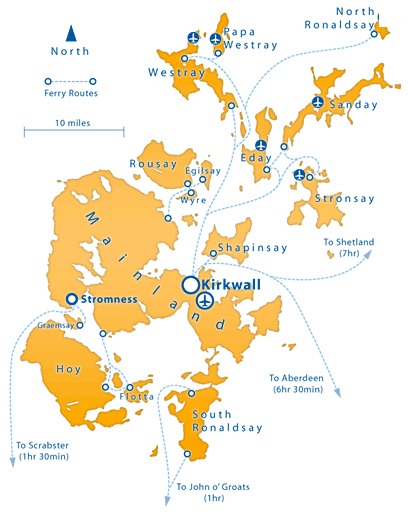The Orkney Islands. Population about 20,000.
The Orkney Islands are an Island group located off the northeast coast of Scotland. They cover an area of some 970 sq. km (375 sq. miles). The capital city of Orkney is Kirkwall, which is also Orkney's administrative centre, and is located on Mainland. The name "Mainland" is derived from the Norse "megitland" meaning big land, because Mainland is the biggest island in the group. The name "Pomona" has also been attached to the Mainland in the past, thanks to a mere scholarly blunder, and can still be found here and there today. For more on this and many other interesting facts regarding Orkney's unique heritage, please visit Sigurd Towrie's excellent Orkneyjar website. The other main town is Stromness, Mainland, which is also the main ferry terminal for services to Scotland as well as to Hoy and Graemesay.

Map of the Orkney Islands
The Orkney Island group comprises about 90 islands and islets. It is low-lying and mainly treeless; it enjoys a mild climate owing to the Gulf Stream. It is best known to the world for its treasure house of carefully preserved historic sites and monuments, the most famous of which is Skara Brae, which is one of the most well preserved Neolithic villages in Europe. It is located on the West Mainland.
Orkney is also famous for its isolated cliff stack known as the Old Man of Hoy, which is of course located on the Island of Hoy. Expert climbers come each year to pit their skill and their wits against this stack, which is regarded as one of the most difficult climbs in the UK.
Deep-sea divers also visit the Island each year to dive on the German warships that formed the remains of the German Fleet, which was scuttled by its Admiral in Scapa Flow on 21st June 1919.
Many people visit the Italian Chapel whilst in Orkney. This chapel was fashioned out of an old Nissan hut, by a group of Italian prisoners of war. The interior of the chapel is decorated in the fashion of the Italian Renaissance.
The Islands are a great place of natural beauty, housing a significant proportion of UK breeding populations of seabirds. Birdwatchers come from all over the country to observe the birds that are resident or to catch a glimpse of a rare migrant, which has been blown here on the wind. Many birds that are blown off course while migrating make landfall in Orkney. On the most northerly of the Island, North Ronaldsay, a Bird Observatory has been established for some years now. As well as birds the islands play host to a significant population of Grey and Common Seals, which come to the Orkney Islands in the Autumn to breed.
Orkney's economy is centred on the traditional Island mainstays of fishing and farming, although tourism is also now forming a significant proportion of the Islands income. There is also income from the Oil Terminal located at Flotta. Orkney produces some of the best beef cattle in the world, but the industry has been set back both by the BSE crisis in the UK lowering market prices, and the recent poor weather affecting the amount and quality of the cattle feed that has been produced. Many local fisherman fish with creels for crab and lobster in much the same way as did their Viking ancestors. Salmon is also farmed and also Arctic Char. Both are also smoked on the Island. Orkney also hosts a small but modern fishing fleet the newest of which is the MV Norlantean. Orkney also boasts two Whisky distilleries in Highland Park and Scapa. These traditional drams are available as single Malts in a variety of ages from 10 to 40 years old! It is hoped that whatever changes, we will always have a "peedie" (small) dram to keep us warm through the winter.
Although the human population has long since been falling, it has in recent years begun to rise again as the islands' remoteness from the rest of the world attracts new settlers. We are among those who have recently settled here within the last 15 years and intend to make this our home for the rest of our lives.